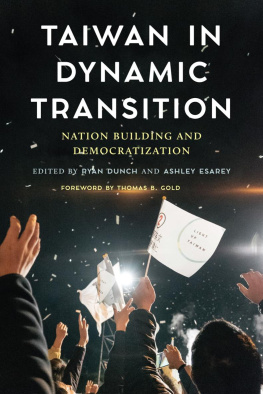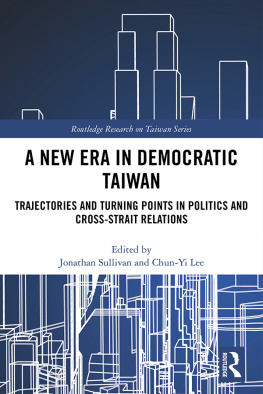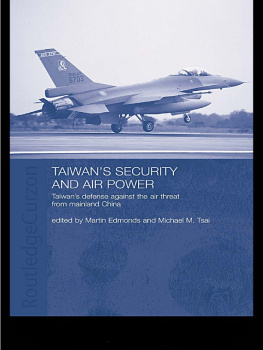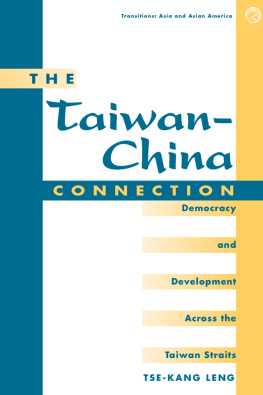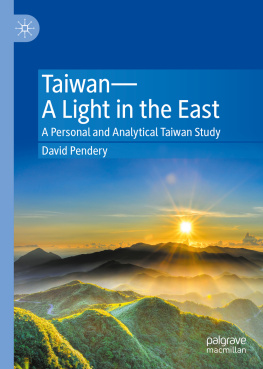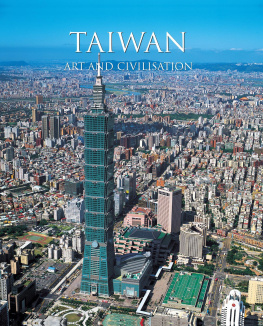TAIWAN IN DYNAMIC TRANSITION
NATION BUILDING AND DEMOCRATIZATION
EDITED BY
RYAN DUNCH AND ASHLEY ESAREY
UNIVERSITY OF WASHINGTON PRESS
Seattle
Taiwan in Dynamic Transition was made possible in part by a Taiwan Studies Grant awarded to the University of Alberta by the Taiwan Ministry of Education.
Copyright 2020 by the University of Washington Press
Printed and bound in the United States of America
Cover and interior design by Katrina Noble
Composed in Warnock Pro, typeface designed by Robert Slimbach
24 23 22 21 20 5 4 3 2 1
All rights reserved. No part of this publication may be reproduced or transmitted in any form or by any means, electronic or mechanical, including photocopy, recording, or any information storage or retrieval system, without permission in writing from the publisher.
UNIVERSITY OF WASHINGTON PRESS
uwapress.uw.edu
LIBRARY OF CONGRESS CATALOGING-IN-PUBLICATION DATA
Names: Dunch, Ryan, 1962 editor. | Esarey, Ashley, editor.
Title: Taiwan in dynamic transition : nation building and democratization / edited by Ryan Dunch and Ashley Esarey.
Description: Seattle : University of Washington Press, [2020] | Includes bibliographical references and index.
Identifiers: LCCN 2019023180 (print) | LCCN 2019023181 (ebook) | ISBN 9780295746821 (hardcover) | ISBN 9780295746807 (paperback) | ISBN 9780295746814 (epub)
Subjects: LCSH: DemocracyTaiwan. | DemocratizationTaiwan. | TaiwanPolitics and government2000
Classification: LCC DS799.847 .T3527 2020 (print) | LCC DS799.847 (ebook) | DDC 320.951249dc23
LC record available at https://lccn.loc.gov/2019023180
LC ebook record available at https://lccn.loc.gov/2019023181
Cover photograph: Taiwan presidential election, January 16, 2016. Studio Incendo / flickr.
The paper used in this publication is acid free and meets the minimum requirements of American National Standard for Information SciencesPermanence of Paper for Printed Library Materials, ANSI Z39.481984.
This volume is dedicated with respect to the Taiwanese, who have made their homeland a vibrant polity and society, providing invaluable lessons to students of history and politics everywhere.
CONTENTS
- THOMAS B. GOLD
- RYAN DUNCH AND ASHLEY ESAREY
- RYAN DUNCH
- ASHLEY ESAREY
- RWEI-REN WU
- JIUNN-RONG YEH
- BENJAMIN L. READ
- KETTY W. CHEN
- CHIA-WEN LEE
- ERIC SETZEKORN
- JA IAN CHONG
FOREWORD
THOMAS B. GOLD
Dynamic and transition are not words one would have associated with Taiwan from the early 1950s until well into the 1970s. Although land reform, compulsory education, and pathways for small and medium-sized businesses opened the door to changes in social structure, politically Taiwan was derided as ossified, pickled in formaldehyde, and a Cold War relic. Studying Taiwan politics was downright boring. So the very fact that this volume includes both of those terms in its title, and that many of the contributors are scholars and activists from Taiwan itself, is testimony to the extraordinary, dare one say miraculous, transformations that have occurred in the political field in the past four decades. Although the focus is on nation building and democratization, the chapters here indicate that Taiwan has undergone and continues to undergo multiple and multifaceted transitions (plural) across all aspects of political life. What is more, the authors situate their essays in the constantly changing global context in which these transitions occur. In thinking about it, I wonder if transformations would not be a better term, as transition implies that there is some endpoint to the process, whereas transformation just indicates changes that are occurring without implying a specific direction.
Given the rapid changes that have taken place within Taiwan, as well as the never-ending onslaught of external challenges, mainly initiated by Beijingwhich often mobilizes other countries to do its biddingTaiwans elected leaders and citizens need to constantly innovate and improvise in order to maintain the islands autonomous albeit liminal existence.
Global context in the subtitle indicates the reality that Taiwan has little control over its international standing, which grows more tenuous by the day. On the one hand, Taiwan has trade relations, multiple forms of exchanges, and quasi-diplomatic offices in most countries around the world, while having formal diplomatic relations with fewer than twenty. Under the Ma Ying-jeou administration (200816), which was more accommodating to Beijing, there was little change in this situation. But since Tsai Ing-wen assumed the presidency in May 2016, Beijing has indicated its displeasure with her refusal to accept the 1992 Consensus acknowledging that there is only one China, by peeling (buying?) away Taiwans diplomatic allies in a slow form of Chinese water torture. Whether or not one believes that Taiwan is a nation, the relevant chapters here provide rich material on how citizens and the authorities have gone about trying to build a sense of a nation and mobilize people to identify with it, against a wide set of internal and external obstacles.
Of course, globalization is more than political and economic ties. As the anthropologist Arjun Appadurai has discussed, globalization can be thought of as flows that move at different levels, different speeds, and different directions. They include flows of people, ideas, finance, technology, and media. In this sense, Taiwan is a very globally plugged-in society, at the receiving and sending ends.
Because Taiwans transformations have been so rapid and thoroughgoing, it is critical that we understand just how much the place has changed, and the nature of its authoritarian legacy. It is gratifying that all of the chapters in this volume are historically informed. They lay out the backstory of The Republic of China and the political institutions that Chiang Kai-sheks Nationalist (Kuomintang) government brought from the mainland and installed beginning in 1945 with the end of World War II and of Japans colonial occupation, and then stepped up, with a great deal of violence and terror, after losing the civil war to the Communists in 1949. Attention is also paid to the legacy of Japanese colonialism, particularly in the structure of neighborhoods, economic development, political activism, and national identity formation.
The various contributors do an excellent job of demonstrating state-society interaction. We can see that the idea of Taiwan being a province of the Republic of China, an ideology introduced and maintained with what Pierre Bourdieu calls symbolic violence from above, has been forcefully challenged from within society as generational change and lack of contact with mainland China have produced new political and intellectual figures who do not share that vision, instead using many methods to build a new nation concentrated on the island, with China as a neighbor. Public opinion polls repeatedly indicate that the vast majority of the people of Taiwan consider themselves primarily Taiwanese and not Chinese and do not support unification with China, certainly not any time soon. Societal challenges have taken place in many forms. Elections are one means by which citizens indicate their support for or opposition to politicians and policies, but social movements and street action, with the 2014 Sunflower Movement as a dramatic case, are a regular means by which citizens participate in politics. Taiwan has a vibrant civil society, and it has raised a vast range of issues requiring attention and resolution by the politicians. Quite clearly, the days of top-down leadership over society have passed. Things that were taken for granted about how Taiwan (the Republic of China) functioned, that were believed to be unchangeable, have sustained repeated challenges and undergone once unthinkable transformation.

